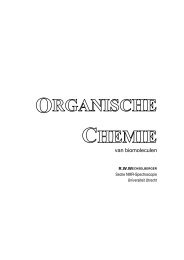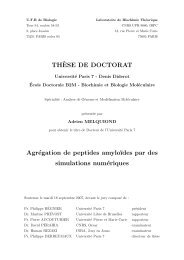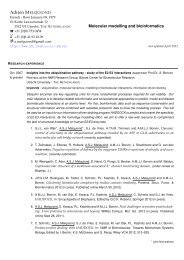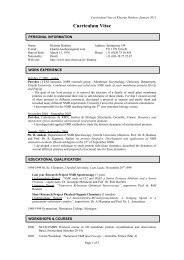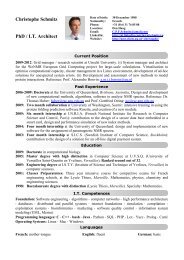Thesis Title: Subtitle - NMR Spectroscopy Research Group
Thesis Title: Subtitle - NMR Spectroscopy Research Group
Thesis Title: Subtitle - NMR Spectroscopy Research Group
You also want an ePaper? Increase the reach of your titles
YUMPU automatically turns print PDFs into web optimized ePapers that Google loves.
50 Chapter 2. Possum: paramagnetically orchestrated spectral solver of unassigned methyls.<br />
criterion that all correlated spins are close in space and therefore experience similar PCS. For<br />
example, 3D (H)CCH-TOCSY or NOESY- 13 C-HSQC spectra would resolve several cross-peaks<br />
for each methyl group, which can simultaneously be compared with the 3D structure of the protein<br />
and the predicted PCS to obtain resonance assignments. For methyl groups in the vicinity of the<br />
paramagnetic ion, the observation of correlations can be aided by protonless experiments (Bermel<br />
et al., 2006).<br />
Conceivably, assignments by PCS can also be achieved for perdeuterated proteins of<br />
increased molecular weight containing selectively protonated methyl groups (Rosen et al., 1996).<br />
The best spectral resolution in the methyl region of the 13 C-HSQC spectrum would be obtained for<br />
CD2H groups (Kainosho et al., 2006).Notably, however, the Cz-EXSY experiments described here<br />
allowed us to measure all PCS data in the uniformly 13 C/ 15 N-labeled and fully protonated sample,<br />
i.e. the improved spectral resolution of selectively labeled samples was not necessary for our<br />
system.<br />
In conclusion, resonance assignments of the 13 C-HSQC cross-peaks of methyl groups by<br />
PCS induced by a site-specifically attached lanthanide ion present a versatile and convenient<br />
technique which can open many opportunities for <strong>NMR</strong> studies of proteins of known three-<br />
dimensional structure. It is anticipated that resonance assignments by this technique will be<br />
particularly useful in ligand screening applications.<br />
2.6 Acknowledgement<br />
The authors thank Don A. Grundel for source codes of the MAP solver and for useful<br />
discussions. M.J. thanks the Humboldt Foundation for a Feodor-Lynen Fellowship. Financial<br />
support from the Australian <strong>Research</strong> Council for project grants, a Federation Fellowship for G.O.<br />
and the 800 MHz <strong>NMR</strong> spectrometer at the ANU is gratefully acknowledged. This work was<br />
supported by an award under the Merit Allocation Scheme of the National Facility of the Australian<br />
Partnership for Advanced Computing.<br />
2.7 Supporting Information Available



